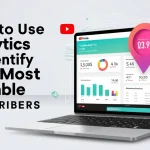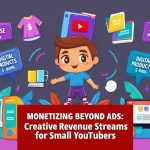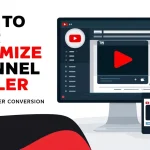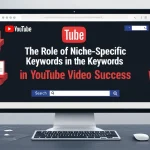In today’s fast-paced digital world, YouTube has solidified its position as one of the most powerful platforms for content creation and marketing. However, relying solely on YouTube’s ecosystem to grow your channel might limit your potential. This is where
cross-platform promotion comes into play. By adopting a
multi-platform strategy, you can amplify your reach, engage diverse audiences, and accelerate your YouTube growth.
In this blog, we’ll delve into the art and science of leveraging cross-platform promotion to take your YouTube channel to the next level.
Understanding Cross-Platform Promotion
What is Cross-Platform Promotion? Cross-platform promotion involves sharing your content or marketing messages across multiple social media platforms to maximize visibility and engagement. For YouTube creators, this means extending your reach beyond YouTube by utilizing platforms like Instagram, TikTok, Facebook, Twitter, and more.
Key Benefits of Cross-Platform Promotion:
- Expanded Audience Reach: Each platform has its unique user base, allowing you to tap into new demographics.
- Stronger Brand Presence: A consistent presence across platforms builds credibility and trust.
- Increased Traffic: Redirect traffic from other platforms to your YouTube channel, boosting views and subscriber counts.
For instance, a short teaser of your latest YouTube video shared on Instagram or TikTok can entice viewers to watch the full content on YouTube.
Why Cross-Platform Promotion is Essential for YouTube Growth
Relying solely on YouTube’s algorithm can be risky. Algorithms change frequently, and competition is fierce. By leveraging other platforms, you reduce dependency on one source and create multiple pathways for users to discover your content. Here’s why cross-platform promotion is a game-changer:
- Enhanced Discoverability: Platforms like TikTok excel at virality, which can drive significant traffic to your YouTube channel.
- Audience Engagement: Interact with followers on platforms like Instagram Stories or Twitter threads, creating deeper connections.
- Brand Consistency: Unified messaging across platforms strengthens your personal or business brand.
Key Strategies for Effective Cross-Platform Promotion
- Content Repurposing: Adapt your YouTube content for other platforms. For example, break down a long YouTube tutorial into bite-sized clips for TikTok or Instagram Reels. Use captions and hashtags to optimize for each platform.
- Teasers and Previews: Share engaging snippets or behind-the-scenes content as a teaser. Add a strong call-to-action like, “Watch the full video on my YouTube channel!” and include the link.
- Collaborations: Partner with influencers or creators who have a strong presence on other platforms. A collaboration video or post can expose your content to a new audience.
- Interactive Engagement: Use polls, Q&A sessions, or contests on platforms like Instagram Stories to drive traffic to your latest YouTube video.
- Cross-Linking: Include your YouTube channel link in your social media bios and posts. Create pinned tweets or highlight sections dedicated to promoting your channel.
Multi-Platform Tools to Streamline Promotion
Managing multiple platforms can feel overwhelming, but the right tools can simplify the process:
- Content Scheduling: Tools like Buffer, Hootsuite, and Later let you schedule posts across platforms, saving time and ensuring consistency.
- Graphic Design: Canva helps you create visually appealing graphics tailored to different platform dimensions.
- Analytics: Use tools like Google Analytics, Sprout Social, or platform-native insights to measure performance and refine your strategy.
Automation can streamline your efforts, but ensure your content remains authentic and personalized to each platform’s audience.
Best Practices for Cross-Platform Promotion Success
- Consistent Branding: Use the same profile picture, color scheme, and tone across all platforms.
- Platform-Specific Optimization: Tailor content to fit each platform’s format and audience preferences. For example, TikTok thrives on short, engaging videos, while LinkedIn prefers professional and informative posts.
- Timing Matters: Post when your audience is most active. Use analytics tools to determine the best times for each platform.
- Diversify Content: Avoid sharing the same post verbatim on every platform. Mix things up with videos, images, text posts, and stories.
Real-Life Case Studies of Successful Cross-Platform Promotion
Example 1: A Beauty Vlogger’s Success A beauty YouTuber repurposed her detailed makeup tutorials into 15-second Instagram Reels and TikTok videos. By using platform-specific hashtags and engaging captions, she directed thousands of new viewers to her YouTube channel, resulting in a 25% increase in subscribers within three months.
Example 2: A Tech Reviewer’s Strategy A tech YouTuber shared Twitter threads summarizing key points from his YouTube videos. These threads gained traction among tech enthusiasts, driving significant traffic to his channel.
Common Mistakes to Avoid in Cross-Platform Promotion
- Over-Promotion: Avoid spamming your audience with constant “Watch my YouTube video” posts. Balance promotional content with value-driven content.
- Ignoring Platform-Specific Norms: Posting YouTube thumbnails directly on Instagram may not resonate. Instead, use visually appealing graphics or images.
- Inconsistency: Neglecting one platform in favor of another can alienate certain segments of your audience.
Measuring Success and Adjusting Your Strategy
Track the success of your cross-platform promotion by monitoring key metrics:
- Click-Through Rates (CTR): Measure how many users clicked on your YouTube link from other platforms.
- Engagement Rates: Track likes, comments, shares, and saves to gauge interest.
- Subscriber Growth: Analyze spikes in YouTube subscribers after specific campaigns.
Use this data to identify what’s working and tweak your approach. For instance, if Instagram drives more traffic than Twitter, focus on optimizing your Instagram strategy.
FAQs: Leveraging Cross-Platform Promotion to Boost YouTube Growth
What is cross-platform promotion, and why is it important for YouTube growth?
Cross-platform promotion involves using multiple social media platforms to promote your YouTube content. It\u2019s important because it helps you reach a wider audience, drive more traffic to your channel, and reduce dependency on YouTube\u2019s algorithm. This strategy enhances visibility and builds a consistent brand presence across platforms.
Which platforms are best for cross-promoting YouTube content?
The best platforms depend on your audience, but some popular options include Instagram, TikTok, Twitter, Facebook, and LinkedIn. Each platform has unique strengths: TikTok for virality, Instagram for visuals and engagement, and Twitter for concise updates and interaction.
How can I repurpose YouTube content for other platforms?
You can break long YouTube videos into short clips for Instagram Reels, TikTok, or Facebook. Use snippets as teasers or highlights and add captions and hashtags tailored to each platform. For written platforms like Twitter or LinkedIn, summarize key points from your videos and include the link to the full content.
How do I track the success of cross-platform promotion?
To measure success, monitor metrics such as click-through rates (CTR) on shared links, engagement rates (likes, shares, comments), and subscriber growth on YouTube. Tools like Google Analytics, platform-native insights, and social media management tools like Sprout Social or Hootsuite can help track performance.
What are common mistakes to avoid in cross-platform promotion?
Some common mistakes include over-promoting, neglecting platform-specific content norms (e.g., using a YouTube thumbnail directly on Instagram), inconsistent posting schedules, and spamming audiences with repetitive posts. Focus on providing value-driven, platform-specific content to build trust and engagement.
Conclusion
Cross-platform promotion is a powerful strategy for unlocking your YouTube channel’s full potential. By repurposing content, engaging audiences on multiple platforms, and using tools to streamline your efforts, you can create a seamless funnel that drives consistent traffic to your channel.
Start implementing these strategies today and watch your YouTube growth soar. Have any cross-platform tips or success stories? Share them in the comments below!
Last Updated: December 24, 2024























Comment (0)
No comments available.